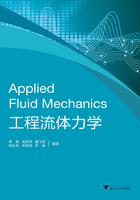
§3.2 Some basic concepts of fluid motion
3.2.1 Euler method on the classification of fluid
1.Steady flow and unsteady flow
(1)Steady flow is the flow whose motion factors (such as flow, density, pressure and viscosity)don't change with time.That is:

So acceleration of euler at constant flow is a=(μ·∇)u.
(2)Unsteady flow is the flow that at least one of its motion factors changes with time.
That is:

As can be seen in Fig.3-1 a, when the level of tank, the traj ectory of j et, the velocity and direction remain constant, it is steady flow.As can be seen in Fig.3-1 b, when the level of tank, the traj ectory of j et, the velocity and direction changes follow time, it is unsteady flow.

Fig.3-1 Steady flow and unsteady flow
2.Uniform flow and non-uniform flow
(1)Uniform flow
The flow have the same velocity including the direction and magnitude at various points following the flow direction.

(2)non-uniform flow
The flow change the same velocity including the direction or magnitude at various points following the flow direction.

3.Gradually varied flow and rapidly varied flow
(1)Gradually varied flow
Gradually varied flow:each flow line close to a straight line parallel to the flow.
(2)Rapidly varied flow
Rapidly varied flow:flow line drastically changed along the non-uniform flow.
4.1-D,2-D and 3-D flow
Categorized according to the number of fluid motion factors.
(1)One-dimensional flow:fluid motion factors are function of a space coordinate.
So u=u(s, t), acceleration of euler is  (see Fig.3-2).
(see Fig.3-2).

Fig.3-2 One-dimensional flow
(2)Two-dimensional flow:fluid motion factors are function of two space coordinate.(Not only limited to rectangular coordinates, see Fig.3-3)

Fig.3-3 Two-dimensional flow
(3)Three-dimensional flow:fluid flow's motion factors are functions of three space Coordinates.For example:water flow in a natural river whose cross section shape and magnitude change along the direction of flow; water flows around the ship.
3.2.2 The description of flow
Three types of curves are commonly used to describe fluid motion-streamlines, pathlines, and streaklines.These are defined and described here assuming that the fluid velocity vector, V, is known at every point of space and instant of time throughout the region of interest.Streamlines, pathlines, and streaklines all coincide when the flow is steady.These curves are often valuable for understanding fluid motion and form the basis for experimental techniques that track seed particles or dye filaments.
1.Streamline
(1)A streamline is a curve that is instantaneously tangent to the fluid velocity throughout the flow field.In unsteady flows the streamline pattern changes with time. The curve indicates the velocity vectors of any points occupying on the streamline(see Fig.3-4).

Fig.3-4 The streamline in a moment
(2)Character of streamline
A.Streamline:many fluid particles, one instant of time (pathline:a fluid particle, a period of time), as can be seen in Fig.3-5.

Fig.3-5 Streamline can not intersect
B.At the same instant of time, streamlines can not intersect.
C.Streamline can't be a folding line, but a smooth curve.
D.In steady flow, streamlines and pathlines coincide.
(3)Equation of streamline
Select point A in streamline, ds is a differential arc length, u is the velocity at point A.In Cartesian coordinates, if ds=(dx, dy, dz) is an element of arc length along a streamline and V=(u, v, w)is the local fluid velocity vector, then the tangency requirement on ds and u leads to
ds=dxi+dyj+dzk, V=ui+vj+wk
so

2.Pathline
A pathline is the traj ectory of a fluid particle of fixed identity.And a pathline is the trace after a single particle travels in a field of flow over a period of time(see Fig.3-6).

Fig.3-6 Pathline
The equation of pathline is: , u, v, w are functions of both time t and space (x, y, z).Here t is an independent variable.
, u, v, w are functions of both time t and space (x, y, z).Here t is an independent variable.
3.Streakline
A streakline is the curve obtained by connecting all the fluid particles that will pass or have passed through a fixed point in space.Streaklines may be visualized in experiments by inj ecting a passive marker, like dye or smoke, from a small port and observing were it goes as it is carried through the flow field by the moving fluid.
Example:
The velocity of a 2-D flow field is u=x+1, v=-y, find the streamline equation of point (1,2).
Solution: 
So: 
Integrate it:ln(x+1)=-ln y+lnC or (x+1)y=C
The streamline equation of point (1,2):
(x+1)y=4
3.2.3 Streamtube, tube flow, cross section, and discharge
1.Streamtube
Consider a closed curve(not streamline)in the flow field, then draw streamlines through every point on it, so as to form a tube-shaping space whose walls are streamlines.This tube is called the streamtube(see Fig.3-7).

Fig.3-7 Stream tube and tube flow
2.Tube flow
Fluid fulling the stream tube is called the tube flow and the limit of a tube flow is a streamline.
3.Cross section
The section is perpendicular to the direction of fluid flow (such as pipe flow and channel flow)(see Fig.3-8).

Fig.3-8 Cross section
4.Discharge
Amount of fluid pass through a cross section (such as the section in the channel or pipe)per unit time.
Volume discharge (m3/s)

Mass discharge (kg/s)

Weight discharge (N/s)

3.2.4 The character of gradually varied flow in cross section
Two important properties of gradually varied flow in cross section:
(1)Flow cross-section of gradually varied flow is approximately flat.Direction of velocity approximately parallel to each point in cross section.
(2) The hydrodynamic pressure of gradually varied flow in cross section approximately distribute according to static pressure law(see Fig.3-9).That is z+ =constant.
=constant.

Fig.3-9 Micro-unit in cross section of gradually
① Gravity G=ρg d A d n

② Pressure on the bottom and up the bottom are -p2dA and p1dA, respectively.
③ Because the flow velocity perpendicular to the plane, velocity along the n direction is zero, so tangential force of cylindrical surface is zero.
④ Under the gradient flow condition, The acceleration is zero alone the n-direction.So there is no inertial force along the direction n.
According to Newton's second law, ∑Fn =0
∑Fn =p 1d A-p 2d A+ρg d A(z 1 -z 2)=0
Simplify
